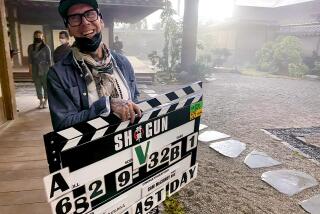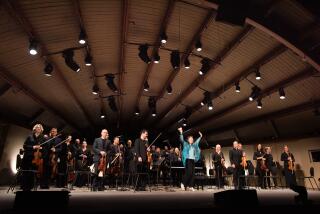Gajin Fujita exhibit at Pacific Asia Museum pays homage to <i>ukiyo-e</i>
- Share via
Dragons, graffiti, cartoon heroes. Gajin Fujita is known for mixing Japanese art with L.A. street and pop culture in paintings fueled by his eclectic imagination and experiences as a Japanese American from Boyle Heights.
The Pacific Asia Museum in Pasadena is spotlighting a major influence on these East-meets-Eastside creations: Fujita’s passion for ukiyo-e, the woodblock prints that flourished in 17th- to 19th-century Japan. “Gajin Fujita: Ukiyo-e in Contemporary Painting,” which opened in April, is what curator Bridget Bray calls “a focused solo exhibition of five pieces in which you see parallels to the print tradition such as dynamic compositions, martial figures, attention to surface detail and dramatization of the natural and supernatural worlds.”
Bray says the paintings, on display through Oct. 7, also offer “points of conversation” with a show of prints and drawings by 19th-century master Tsukioka Yoshitoshi that opens May 18.
In discussing his exhibition, Fujita notes that “Shore Line Duel” (2004) “directly references a popular print.” In it, samurai battle before a graffiti-streaked background — layers of motifs and media being Fujita hallmarks. (To create his pieces, which range from intimate to mural-sized, he covers wood panels with gold, silver and platinum leaf, tags them and uses spray paint, stencils and paint markers.)
In “Golden Boy After Kuniyoshi” (2011), Fujita says he “did away with having the graffiti and title be the stronger imagery.” He also experimented with spray paint to achieve different surface effects and gave the legendary boy “demon” and “L.A.” tattoos. “I want my paintings to be contemporary and not just reproductions of ukiyo-e, so I insert bits of things that are contemporary.”
While graffiti is “something I once practiced myself,” the artist says, his fascination with ukiyo-e began in his early 20s when he saw prints his mother, an antique restorer, brought home.
At 40, Fujita, represented by L.A. Louver, has seen his reputation continue to grow. (Last spring, Times art critic Christopher Knight wrote that his “paintings merging tagging with the ‘floating world’ of traditional Japanese ukiyo-e are the most important 21st century iteration of graffiti’s influence on art.”)
“I like the direction my recent pieces are taking,” Fujita says. “But any evolution has been subtle. My art is still based on my [interest] in woodblock prints.” He can’t predict where his work is heading. “But I’ll try to keep honing my skills to get closer to being on par with the ukiyo-e masters. And I want to keep violating people’s expectations.”
More to Read
The biggest entertainment stories
Get our big stories about Hollywood, film, television, music, arts, culture and more right in your inbox as soon as they publish.
You may occasionally receive promotional content from the Los Angeles Times.










